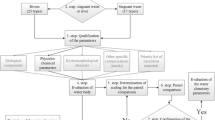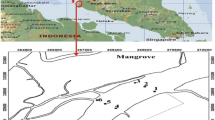Abstract
Comparative analysis of approaches and methods of biological assessment of water quality is presented. A method of ecotoxicological diagnostic of aquatic ecosystem “health” and water quality evaluation based on the physiological state of fish are substantiated. Characteristics of the main symptoms of diseases in fish inhabiting freshwater bodies and pathologic disturbances in their organs and tissues, caused by water bodies’ contamination with toxic substances, are presented. The method of ecotoxicological assessment of water quality is shown to be both highly informative and easy-to-use in practical monitoring.
Similar content being viewed by others
REFERENCES
Abakumov, V.A., Ecological Modifications and the Development of Biocenoses, in Ekologicheskie modifikatsii i kriterii ekologicheskogo normirovaniya (Ecological Modifications and Ecological Standardization Criteria), Leningrad, 1991, pp. 18–41.
Abakumov, V.A. and Sushchenya, L.M., Hydrobiological Monitoring fo Freshwater Ecosystems and the Lines of Its Improvement, in Ekologicheskie modifikatsii i kriterii ekologicheskogo normirovaniya (Ecological Modifications and Ecological Standardization Criteria), Leningrad: Gidrometeoizdat, 1991, pp. 41–52.
Alabaster, Dzh. and Lloid, R., Kriterii kachestva vody dlya presnovodnykh ryb (Water Quality Criteria for Freshwater Fish), Moscow: Legkaya i pishch. prom-st’, 1984.
Arshanitsa, N.M., Materials of Ichthyotoxicological Studies in the Ladoga Basin, in Vliyanie zagryaznenii na ekosistemu Ladozhskogo ozera (Pollution Impact on the Ladoga Ecosystem), Leningrad: GosNIORKh, 1988, pp. 12–23.
Braginskii, L.P., Some Principles of Classification of Freshwater Ecosystems According to Toxic Pollution Levels, Gidrobiol. Zh., 1985, vol. 21, pp. 57–67.
Venitsianov, E.V. and Kuz’mich, V.N., On Methods for Calculating Standards of Maximum Admissible Chemical Load on Water Bodies, Melior. Vodn. Khoz., 2000, no. 3, pp. 36–38.
GOST (State Standard) 27065-86. Water Quality. Terms and Definitions, Moscow: Izd. Standartov, 1987, p. 9.
Dolgonosov, B.M. and Kocharyach, A.G., Standardization Basis for the Environmental State of Water Quality, Inzh. Ekologiya, 1988, pp. 19–39.
Edinye kriterii kachestva vod. Soveshchanie rukovoditelei vodokhozyaistvennykh organov stran-chlenov SEV (Unified Criteria for Water Quality. Meeting of Heads of Water Management Agencies of CMEA Countries), Moscow: SEV, 1982, p. 82.
Zhiteneva, L.D., Poltavtseva, T.G., and Rudnetskaya, O.A., Atlas normal’nykh i patologicheskikh izmenennykh kletok krovi ryb (Atlas of Normal and Pathologic Modified Blood Cells of Fish), Rostov-on-Don: Rostovskoe Kn. Izd., 1989, vol. 110.
Zhulidov, A.V. and Khoruzhaya, T.A., Rekomendatsii. Metody toksikologicheskoi otsenki zagryazneniya ekosistem (Recommendations. Methods for Toxicological Assessment of Ecosystem Pollution), Moscow: Gidrometeoizdat, 1994.
Ivanova, N.T., Method of Morphological Analysis of Blood in Ichthyopathoogical Studies, Izv. Gos. Nauchn.-Issled. Inst. Ozerov. Rybn. Khoz., 1976, no. 105, pp. 114–117.
Krylov, O.N., Posobie po profilaktike i diagnostike otravlenii ryb vrednymi veshchestvami (Textbook on Prophylactics and Diagnosing of Fish Poisoning by Hazardous Subatances), Moscow: Pishchevaya promyshlen-nost’, 1980.
Laskorin, B.N. and Luk’yanenko, V.I., Strategy and Tactics of Water Body Protection against Pollution, II Vse-soyuz. konf. po rybokhozyaistvennoi toksikologii (II All-Union Conf. on Fish Toxicology), St. Petersburg, 1991, pp. 5–8.
Lesnikov, L.A., System of Studies for the Development of Fishery-Related Water Quality Standards with Allowance Made for the Problems of Transfer of Experimental Data to Natural Water Bodies, in Vliyanie zagryaznyayushchikh veshchestv na gidrobiontov i ekosistemy vodoemov (Pollution Effect on Aquatic Animals and Ecosystems of Water Bodies), Leningrad, 1979, pp. 301–309.
Lukin, A.A., Dauval’ter, V.A., and Novoselov, A.P., Ekosistema Pechory v sovremennykh usloviyakh (Ecosystem of the Pechora under Present-Day Conditions), Apatity: Izd-vo KNTs RAN, 1999.
Lukin, A.A. and Sharova, Yu.N., Water Quality Estimation Based on Histological Investigations of Fish: Case Study of Kenozero Lake, Vodn. Resur., 2004, no. 4, pp. 481–489 [Water Resour. (Engl. Transl.), no. 4, pp. 443-449].
Luk’yanenko, V.I., Ecological Standardization and Fishery-Related Regulation of Water Pollution in Streams and Water Bodies, Tez. dokl. I Vsesoyuz. konf. po rybokhozyaistvennoi toksikologii (I All-Union Conf. on Fish Toxicology), Riga, 1989, pp. 21–23.
Metelev, V.V., Kanaev, A.I., and Dzasokhova, N.G., Vodnaya toksikologiya (Aquatic Toxicology), Moscow: Kolos, 1971.
Metodicheskie ukazaniya po ustanovleniyu ekologorybokhozyaistvennykh normativov (PDK i OBUV) zagryaz-nyayushchikh veshchestv dlya vody vodnykh ob” ektov, imeyushchikh rybokhozyaistvennoe znachenie (Methodological Recommendations for Establishing Environmental and Fishery Standards (MAC and SRLI) for Pollutants in Water of Water Bodies Used for Fishery), Filenko, O.F., Ed., Moscow: VNIRO, 1998.
Mikheev, N.N. et al., Maximum Admissible Environmental Loads on Water Bodies and the Optimization Principles of Water Protection Measures, Inzh. Ekologiya, 1997, no. 2, pp. 19–28.
Moiseenko, T.I., Anthropogenic Variations in Freshwater Ecosystems and Criteria of Water Quality Assessment, in Problemy ekologicheskogo monitoringa i modelirovaniya ekosistem (Problems of Enviromental Monitoring and Modeling of Ecosystems), St. Petersburg: Gidrometeoizdat, 2003, no. 6, pp. 72–94.
Moiseenko, T.I., Hematologic Characteristics of Fish in the Assessment of Their Toxicoses, Vopr. Ikhtiol., 1998, no. 2, pp. 371–380.
Moiseenko, T.I., Teoreticheskie osnovy normirovaniya antropogennykh nagruzok na vodoemy Subarktiki (Theoretical Principles of Standardization of Anthropogenic Load on Water Bodies in the Subarctic Region), Apatity: KNTs RAN, 1997.
Moiseenko, T.I. and Lukin, A.A., Fish Pathologies in Polluted Water Bodies in the Subarctic Region and Their Diagnosing, Vopr. Ikhtiol., 1999, no. 4, pp. 535–547.
Nikanorov, A.M. and Trunov, N.M., Vnutrivodoemnye protsessy i kontrol’ kachestva prirodnykh vod (Processes in Water Bodies and Natural Water Quality Control), St. Petersburg: Gidrometeoizdat, 1999.
Odum, E.P., Fundamentals of Ecology, Philadelphia: W.B. Saunders, 1971.
Perechen’ rybokhozyaistvennykh normativov predel’nodopustimykh kontsentratsii (PDK) i orientirovochno bezopasnykh urovnei vozdeistviya (OBUV) vrednykh veshchestv dlya vody vodnykh ob” ektov, imeyushchikh rybokhozyaistvennoe znachenie (List of Fishery-Related Standards on Maximum Admissible Concentrations (MAC) and Safe Reference Levels of Impact (SRLI) of Hazardous Substances for Water Bodies Used for Fishery), Moscow: VNIRO, 1999, p. 304.
Reshetnikov, Yu.S., Expert Evaluation Method for the State of an Individual and a Population of Witefish, in Biologiya i biotekhnika razvedeniya sigovykh ryb (Biology and Biotechniques of Whitefish Breeding), St. Petersburg: GosNIORKh, 1994, pp. 115–118.
Rozenberg, G.S. and Krasnoshchekov, G.P., Volzhskii bassein: Ekologicheskaya situatsiya i puti ratsional’nogo prirodopol’zovaniya (Volga Basin: The Environmental Situation and the Ways of Rational Nature Management), Tolyatti: Inst. Ekol. Volzhs. Bas., 1996.
Rukovodstvo po gidrobiologicheskomu monitoringu presnovodnykh ekosistem (Manual on Hydrobiological Monitoring of Freshwater Ecosystems), Abakumov, V.A., Ed., St. Petersburg: Gidrometeoizdat, 1992.
Savvaitova, K.A., Chebotarev, Yu.V., Pichugina, M.Yu., and Maksimov, S.V., Anomalies in Fish Organisms as Indications to the Environmental Conditions, Vopr. Ikhtiol., 1995, no. 2, pp. 182–188.
Sidorov, V.S. and Yurovitskii, Yu.G., Perspectives of the Use of Biochemical Methods for Recording Ecological Modulations, in Ekologicheskie modifikatsii i kriterii ekologicheskogo normirovaniya (Ecological Modifications and Environmental Standardization Criteria), Leningrad: Gidrometeoizdat, 1991, pp. 264–278.
Sidorov, V.S., Nemova, N.N., and Vysotskaya, R.U., The Use of Integral Biochemical Index for the Assessment of MAC and Biochemical Changes in Fish under Toxic Impacts, Sovremennye problemy vodnoi toksikologiii. Tez. Dokl. (Abstracts of Papers. Present-Day Problems of Aquatic Toxicology), Borok, 2002, pp. 121–122.
Stroganov, N.S., Biological Aspect of the Problem of Norm and Pathology in Aquatic Toxicology, in Teoreticheskie problemy vodnoi toksikologii (Theoretical Problems of Aquatic Toxicology), Moscow: Nauka, 1983, pp. 5–21.
Flerov, B.A., Ekologo-fiziologicheskie aspekty toksikologii presnovodnykh zhivotnykh (Ecological and Physiological Aspects of Freshwater Animal Toxicology), Leningrad: Nauka, 1989.
Chinareva, I.D., Pathologic Histological Changes in Fish of the Ladoga Basin, in Vliyanie zagryaznenii na ekosistemu Ladozhskogo ozera (Pollution Impact on the Ladoga Ecosystem), Leningrad: GosNIORKh, 1988, pp. 24–32.
Sharova, Yu.N., Functioning of the Reproduction System of Fish in the Extreme North Regions under Anthropogenic Pollution (Case Study of the Whitefish Soregonus lavaretus L.), Extended Abstract of Cand. Sci. (Biol.) Dissertation, Petrozavodsk, 1999.
Shatunovskii, M.I., Akimova, N.V., and Ruban, G.I., Response of Reproduction System to Anthropogenic Impact, Vopr. Ikhtiol., 1996, vol. 36, no.2, pp. 229–247.
Shvarts, S.S., Ekologicheskie zakonomernosti evolyutsii (Ecological Regularities of Evolution), Moscow: Nauka, 1980.
Adams, S.M. and Ryon, M.G., A Comparison of Health Assessment Approaches for Evaluating the Effects of Contaminant-Related Stress on Fish Populations, J. Aquatic Ecosystem Health, 1994, no. 3, pp. 15–25.
Aquatic Toxicology and Hazard Assessment: 10th Volume, Adams, W.., Chapman, A., and Landis, W., Eds., Philadelphia, 1988.
Bioassay Methods for Aquatic Organisms, Standart Methods for the Examination of Water and Wastewater, Washington, DC: Amer. Public Health Assoc., 1985, pp. 45–52.
Bitton, G. and Dutku, B.J., Introduction and Review of Microbial and Biochemical Toxicity Screening Procedures, Standart Methods for the Examination of Water and Wastewater, Washington, DC: Amer. Public Health Assoc., 1985, pp. 31–40.
Cash, K.J., Assessing and Monitoring Aquatic Ecosystem Health—Approaches Using Individual, Population, and Community/Ecosystem Measurements. Northern River Basins Study Project Report, 1995, no. 45.
Chronic Toxicity Test Standard Using Daphnids in Renewal and Flowthrough System. Office of Testing and Evaluation. Office of Pesticides Toxic Substances, Washington, DC: Environ. Protection Agency, 1980, p. 351.
Henriksen, A., Kamari, I., Posch, M., and Wilander, A., Critical Loads of Acidity: Nordic Surface Waters, AMBIO, 1992, no. 21, pp. 356–363.
Houlihan, D.F., Carter, G.G., and McCarthy, I.D., Protein Synthesis in Fish, Biochem. Molecular Biol. Fishes, Amsterdam: Elselvier, 1995, pp. 191–220.
Levin, S.A. and Kimball, K.D., New Perspectives in Ecotoxicology, Environ. Manag., 1984, vol. 8, pp. 375–442.
Literature Review of the Effects of Persistent Toxic Substances on Great Lakes Biota, Ottawa: Government Printing Office. Intern. Joint Comm, 1986.
Measuring and Modeling the Dynamic Response of Remote Mountain Lake Ecosystems to Environmental Change, Norway: NIVA, 1997.
Munawar, M., Dixon, G., and Mayfield, C.I., Environmental Bioassay Techniques and Their Application [Special Issue], Hydrobiologia, 1989, vol. 188/189, p. 680.
Munkittnck, K.R. and Dixon, D.G., A holistic Approach to Ecosystem Health Assessment Using Fish Population Characteristics, Hydrobiology, 1989, vol. 188/189, pp. 123–135.
Niimi, A.J., Review of Biochemical Methods and Other Indicators to Assess Fish Health in Aquatic Ecosystems Containing Toxic Chemicals, J. Great Lakes Res., 1990, vol. 16, pp. 529–541.
Organization for Economic Co-Operation and Development Guidelines for Testing of Chemicals. Effects on Biotic Systems, Paris, 1981.
Staaf, H., Critical Loads/Levels as a Tool for Implementing National Strategies for Pollution Control, Critical Loads and Critical Limit Values, Finland, 1994, pp. 151–156.
The Role of Biochemical Indicators in the Assessment of Ecosystem Healh. Their Development and Validation, Publ. National Research Council of Canada, no. 24371, Ottawa, 1985.
Werd, J.H. and Komen, J., The Effects of Chronic Stress on Growth in Fish: Critical Appraisal, Comp. Biochem. Physiol., 1998, no. 120, pp. 107–112.
Wong, P.T.S. and Dixon, D.G., Bioassessment of Water Quality, Environ. Toxicol. Water Quality, 1995, vol. 10, pp. 9–17.
Author information
Authors and Affiliations
Additional information
Translated from Vodnye Resursy, Vol. 32, No. 2, 2005, pp. 184–195.
Original Russian Text Copyright © 2005 by Moiseenko.
Rights and permissions
About this article
Cite this article
Moiseenko, T.I. Ecotoxicological approach to water quality assessment. Water Resour 32, 163–174 (2005). https://doi.org/10.1007/s11268-005-0021-4
Received:
Issue Date:
DOI: https://doi.org/10.1007/s11268-005-0021-4




